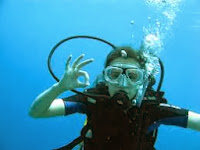Different types of diving for beginners
If you have
thought to go diving, but you know nothing about diving. Fear not, for you I
will help with some great basic information about diving. The first question we
need to ask is; When diving. According to the Webster's dictionary diving is
defined as one that swim under water using scuba gear. The word-dive is an
acronym for independent underwater-breathing apparatus. So basically if you do
not have an alien device that you are you are not diving.
Now that you have a vague idea of what diving is and you are ready to make your first jump, maybe we should discuss the different types of diving there.
There is diving,
free diving and deep diving. Technically, plunged free is not a form of diving,
it is recommended to do before actually diving. Free-diving is one of the
various aquatic activities that share the practice of apnea under water.
Snorkeling is super useful for exercises and practice the vin of breathing.
Snorkeling is the practice of swimming through water using a snorkel. A tuba is
essentially a tube that goes from the mouth and sticks out of the water so you
intake air can. Snorkeling is the method recommended for diving. You can see
the underwater life in a natural environment, but due to limitations with the
length of the tube your do not go for very deep.
This brings us to deep diving or diving in principle.
Scuba diving,
itself consists of six types of diving. These are: the open water diving, night
Diving, rescue diving, cave diving, wreck, and finally drift diving. Open water
dives are the most basic and the most common types of diving. Are called open
water diving because if there is a problem a the atmosphere with drag to
breathe air. In contrast to the cave and wreck diving. You're not a scuba diver
until you get your first level of certification which States you certified to
dive in open water (as opposed to the controlled environment of a swimming
pool).
Rescue diving is exactly what it is, diving rescue. Not everyone can only be a Rescue Diver, dive rescue skills are very hard to come by. As a Rescue Diver you will learn:
Transporte-including
the ' right ' swimming training and surface transport
Surface
rescue-including first aid while floating in open water
Deep rescue-help
and pick up a victim of depth
Strategies for
boat diving side of emergencies
FIRST AID-if CPR,
wound dressing, technical of immobility
Aquatic first aid
similar to lifeguard skills
For those who
want to keep their diving skills to higher levels and work as a scuba diving
instructor, Captain or guide, rescue diving certification is recommended.
Night dives are for those who want a variety more sea creatures.
As with all of
the above habitat or under the sea not all animals are awake during the day.
Some fish want to walk at night. You should definitely take a course before
attempting a night dive. You must also dipping during the day where you will be
immersed in the night to some familiarity with this area and field. During a
night dive you should always a torch or a flashlight. (more back-up)
Diving was nothing like open water dives.
Though the fact
that you are not in the open air. Open water divers are used to are not fully
surrounded and with the freedom to move and swim anywhere they want. Diving is
different; you will often be a preset by narrow crevices in large
"rooms" path. Due to in a cave, it has no source of natural light and
dive you would further diving equipment. You need a torch under the water or
underwater light. Once you're past the entrance, you will not be able to see
without it. The darkness is absolute. The only light you will get is the light
that you take with you. As part of your training you should know how the band
attach to your wrist or buoyancy compensating device (BCD) to make sure it's
not lost will, as it has fallen. As exciting as it is to be immersed in a cave,
there are few things more frightening than to be in a basement, without light
disoriented. Divers always dive with a buddy, but in the cave diving a buddy
with a light can save your life if your lamp is burned out, broken or
accidentally fell and lost.
Wreck diving has
the same concept as diving with his penetration, but diving is something
totally different movements by itself. Special training is required if a wreck
diver. All enclosed spaces of submarines were a potential danger, but wrecks
usually Yes, given that the structures often fragile, unbalanced or unstable,
with poor visibility.
This brings us to drift diving.
Drift diving is a
great way to relax, it's also a great way to maintain your tank and stay longer
immersed. Drift diving the diver descends in the water with a known current and
after the current along the Porter can obtain neutral buoyancy. When the drift
diving is need a boat for you, but also, because once you start you will soon
drift away from your point of val-often much faster that you realize or wait.
It is important to take into account the direction of the tide, as well as
their strength to prevent divers swept into dangerous areas such as waterways.
It is also important to reduce the risk of separation or under water, or at the
surface to predict. Every diver should have a suitable signalling device and
the compass.
